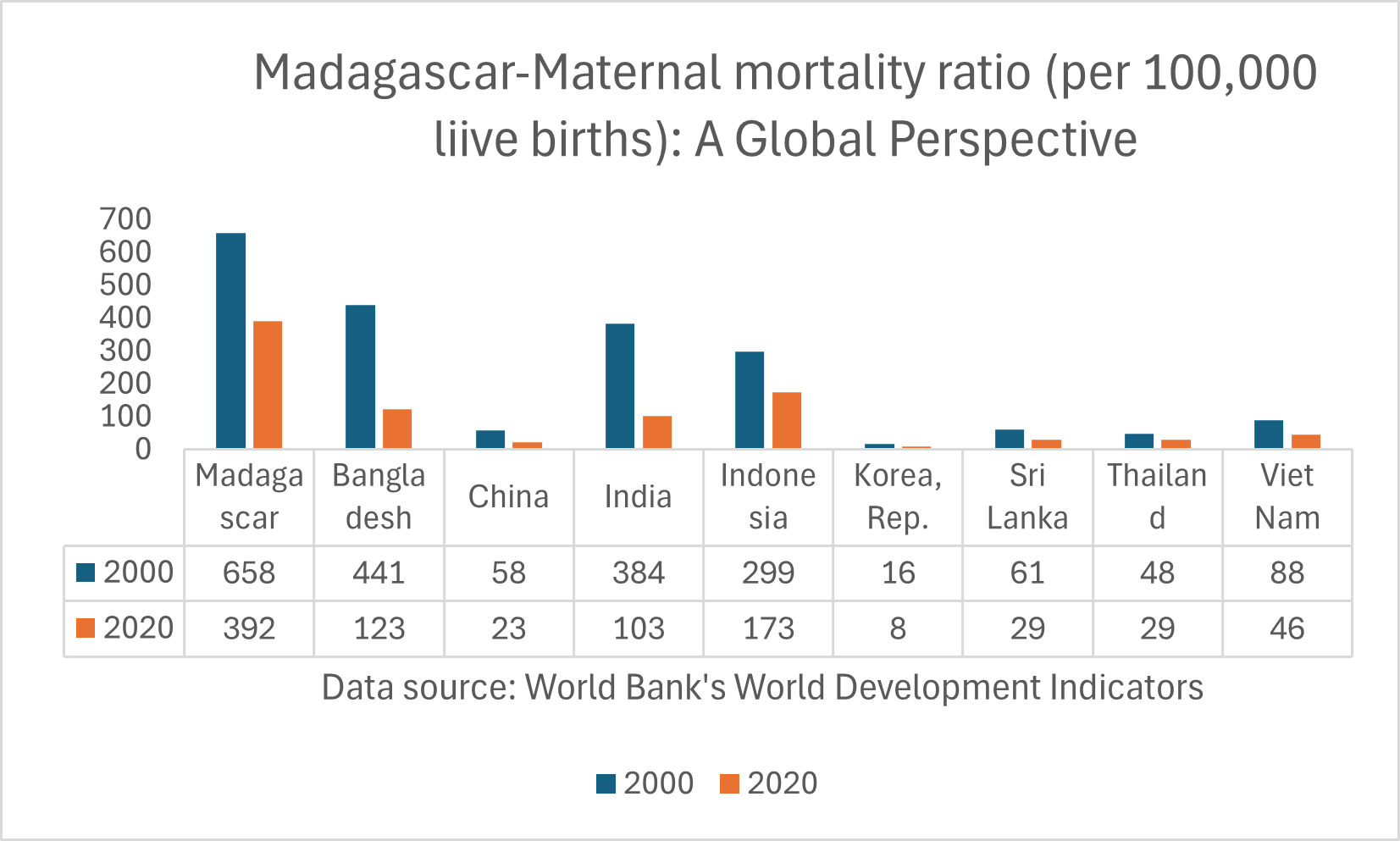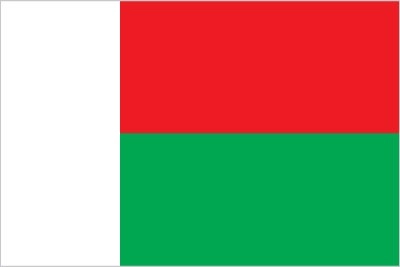
Madagascar
Country Flag Details
two equal horizontal bands of red (top) and green with a vertical white band of the same width on hoist side; by tradition, red stands for sovereignty, green for hope, white for purity
Background
Madagascar was one of the last major habitable landmasses on earth to be settled by humans. Madagascar was a pirate stronghold during the late 17th and early 18th centuries. The French conquered the island in 1896 and made it a colony. Independence was regained in 1960.
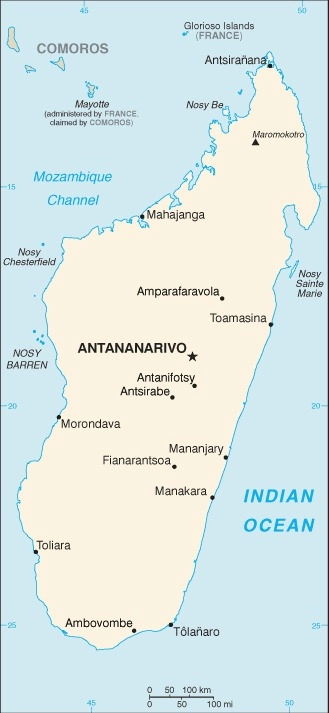
Geography
Area
total : 587,041 sq km
land: 581,540 sq km
water: 5,501 sq km
Climate
tropical along coast, temperate inland, arid in south
Natural resources
graphite, chromite, coal, bauxite, rare earth elements, salt, quartz, tar sands, semiprecious stones, mica, fish, hydropower
People and Society
Population
total: 29,452,714
Ethnic groups
Malayo-Indonesian (Merina and related Betsileo), Cotiers (mixed African, Malayo-Indonesian, and Arab ancestry – Betsimisaraka, Tsimihety, Antaisaka, Sakalava), French, Indian, Creole, Comoran
Languages
Malagasy (official) 99.9%, French (official) 23.6%, English 8.2%, other 0.6% (2018 est.)
Religions
Church of Jesus Christ in Madagascar/Malagasy Lutheran Church/Anglican Church 34%, Roman Catholic 32.3%, other Christian 8.1%, traditional/Animist 1.7%, Muslim 1.4%, other 0.6%, none 21.9% (2021 est.)
Population growth rate
2.18% (2024 est.)
Government
Government type
semi-presidential republic
Executive branch
chief of state: President Andry RAJOELINA (since 16 December 2023)
head of government: Prime Minister Christian NTSAY (since 6 June 2018)
Economy
Economic overview
low-income East African island economy; natural resource rich; extreme poverty; return of political stability has helped growth; sharp tax revenue drop due to COVID-19; leading vanilla producer; environmentally fragile
Real GDP (purchasing power parity)
$51.265 billion (2023 est.)
$49.388 billion (2022 est.)
$47.488 billion (2021 est.)
Real GDP per capita
$1,600 (2023 est.)
$1,600 (2022 est.)
$1,600 (2021 est.)
Exports
$4.689 billion (2022 est.)
$3.362 billion (2021 est.)
$2.589 billion (2020 est.)
Exports – partners
USA 16%, France 15%, Japan 8%, China 6%, S. Korea 6% (2023)
Exports – commodities
garments, nickel, vanilla, cloves, gold (2023)
Imports
$6.041 billion (2022 est.)
$4.769 billion (2021 est.)
$3.718 billion (2020 est.)
Imports – partners
China 19%, Oman 13%, France 10%, India 8%, South Africa 5% (2023)
Imports – commodities
refined petroleum, rice, fabric, cotton fabric, wheat (2023)

Export structure by product group in 2023 (% of total exports) (UNCTAD)
The export structure of a country reflects the variety, composition, and value of its internationally traded goods and services, acting as a vital indicator of its economic health, competitive position, and level of development. Madagascar’s economy is predominantly driven by agriculture and natural resources, yet there is an emerging trend towards industrialization and value-added processing that is starting to reshape its economic landscape. Although the nation faces multiple challenges, such as infrastructural deficits and market access issues, strategic and targeted investments in promising sectors like mining, textiles, and agro-processing could significantly enhance its export competitiveness. By fostering innovation and efficiency in these industries, Madagascar has the potential not only to stimulate economic growth but also to elevate its standing in the global market, creating a more resilient and diversified economy in the long run.
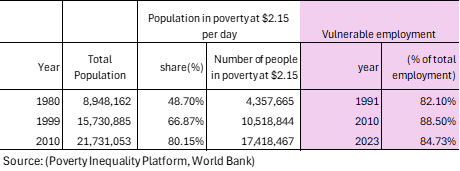
Poverty and vulnerable employment in Madagascar
In 2023, a striking 85 percent of Madagascar’s total employment was categorized as vulnerable employment, a term that refers to work characterized by inadequate job security, low wages, and a lack of essential social protections such as health insurance, pensions, or labor rights. This category primarily includes Own-Account Workers, who are self-employed individuals without employees, like street vendors and small-scale farmers, as well as Contributing Family Workers, who assist in family businesses or farms without formal compensation. Such positions are frequently informal and unstable, leading to a lack of benefits that make workers especially vulnerable to economic shocks, exploitation, and poverty. The repercussions of vulnerable employment extend beyond the individual level, impacting families and communities while perpetuating cycles of instability and hardship that are difficult to overcome.
Undesratanding poverty level significance at $2.15 per day
In 2010, a significant 80 percent of Madagascar’s population (22 million people) was identified as living in poverty at an income threshold of $ 2.15 per day, The poverty level at $2.15 per day (measured in 2017 purchasing power parity, or PPP) is a key global benchmark used by the World Bank to define extreme poverty in low-income countries. It indicates:
1. Basic Survival Threshold
• People living below $2.15 per day struggle to afford essential needs such as food, clean water, shelter, healthcare, and education.
2. Economic Underdevelopment
• A high percentage of a country’s population living below this threshold suggests low economic productivity, high unemployment, and weak social safety nets.
3. Inequality and Social Vulnerability
• It reflects deep income inequality and a lack of access to opportunities for upward mobility.
• People in this category are more vulnerable to shocks like food price increases, climate disasters, or health crises.
4. Policy Challenges
• Governments need targeted interventions such as social welfare programs, job creation, and improved access to education and healthcare to reduce poverty.
A country's export structure is a reflection of its level of development and productive capacities
The export structure of a country refers to the composition, diversity, and value of the goods and services it sells to other countries. It provides key insights into the country’s economic health, competitiveness, and level of development. Productive capacities of a country refer to its ability to produce goods and services efficiently and sustainably over time. These capacities are shaped by various factors, including human capital, natural resources, infrastructure, private sector, development, technology & innovation, institutions & governance, financial systems trade & market access.
Here’s what the export structure and productive capacities of a country typically indicate:
- Level of Economic Development
- Developed economies usually export high-value manufactured goods, technology, and services.
- Developing economies often rely on raw materials, agricultural products, or low-value manufactured goods.
- Industrial and Sectoral Strengths
- A strong presence of high-tech or industrial goods (e.g., machinery, electronics) suggests a well-developed manufacturing sector.
- A dominance of commodities (e.g., oil, minerals, agricultural products) indicates reliance on natural resources.
- Export Diversification
- A diverse export base (multiple industries) makes a country’s economy more stable and resilient to global price shocks.
- A concentrated export base (few key products) makes it vulnerable to market fluctuations.
- Trade Partnerships and Dependence
- If exports are heavily dependent on a single country or region, the economy is more exposed to geopolitical and trade risks.
- A wide range of trading partners indicates stronger global integration.
- Competitiveness and Value Addition
- Exporting mainly raw materials (e.g., crude oil instead of refined petroleum) suggests limited industrial processing capacity.
- A high share of finished and high-tech goods suggests strong value addition and competitiveness.
Madagascar-Sanitation
Madagascar – Proportion of population served with at least basic sanitation
In 2022, proportion of population served with at least basic sanitation for Madagascar was 14.8 %. Proportion of population served with at least basic sanitation of Madagascar increased from 3.8 % in 2000 to 14.8 % in 2022 an absolute change of 11 percentage points (pp) between 2000 and 2022.
Madagascar – Proportion of urban population served with at least basic sanitation
In 2022, proportion of urban population served with at least basic sanitation for Madagascar was 21.6 %. Proportion of urban population served with at least basic sanitation of Madagascar increased from 9 % in 2000 to 21.6 % in 2022 an absolute change 12.6 pp between 2000 and 2022.
Madagascar – Proportion of rural population served with at least basic sanitation
In 2022, proportion of rural population served with at least basic sanitation for Madagascar was 10.2 %. Proportion of rural population served with at least basic sanitation of Madagascar increased from 1.9 % in 2000 to 10.2 % in 2022 an absolute change of 8.3 pp between 2000 and 2022.
Madagascar – Proportion of population served with at least basic sanitation: A Global Perspective
The dire state of sanitation in Madagascar represents a critical crisis that requires immediate action, contributing to preventable deaths for hundreds of thousands annually and highlighting a significant public health emergency. Access to safe sanitation is a fundamental human right that must be assured for all. In 2022, around 26 million people, nearly 85 percent of Madagascar’s population, faced the dire consequences of inadequate sanitation facilities, a situation that sharply contrasts with other nations where the lack of these services is much lower, such as Vietnam, China, and Thailand at just 8 percent, 5 percent, and 1 percent respectively. With a global average of approximately 6 percent lacking adequate sanitation, there is an urgent need for collaborative efforts to improve access in the neglected regions of Sub-Saharan Africa. This urgency demands a holistic approach that includes community involvement, governmental responsibility, and international support, recognizing that the health and dignity of countless individuals depend on our collective commitment to uphold sanitation as the vital human right.

Madagascar – Proportion of rural population served with at least basic sanitation: A Global Perspective
In 2022, nearly 16 million people in rural Madagascar, representing about 90 percent of the rural population, faced the grim reality of lacking basic sanitation facilities. In contrast, countries like Vietnam, Sri Lanka, and Thailand reported only 12 percent, 5 percent, and 2 percent of their populations in similar circumstances. The shortage of safe sanitation is not just urgent; it is a critical crisis demanding immediate collective action, resulting in preventable deaths and worsening public health. Safe sanitation is a fundamental human right that all individuals deserve, and we must unite to advocate for this essential right across Sub-Saharan Africa. The situation in Madagascar highlights our moral obligation to ensure that all, especially the most vulnerable, have access to the dignity and health that proper sanitation and hygiene services provide, fostering a future where every individual can live with their basic rights honored.
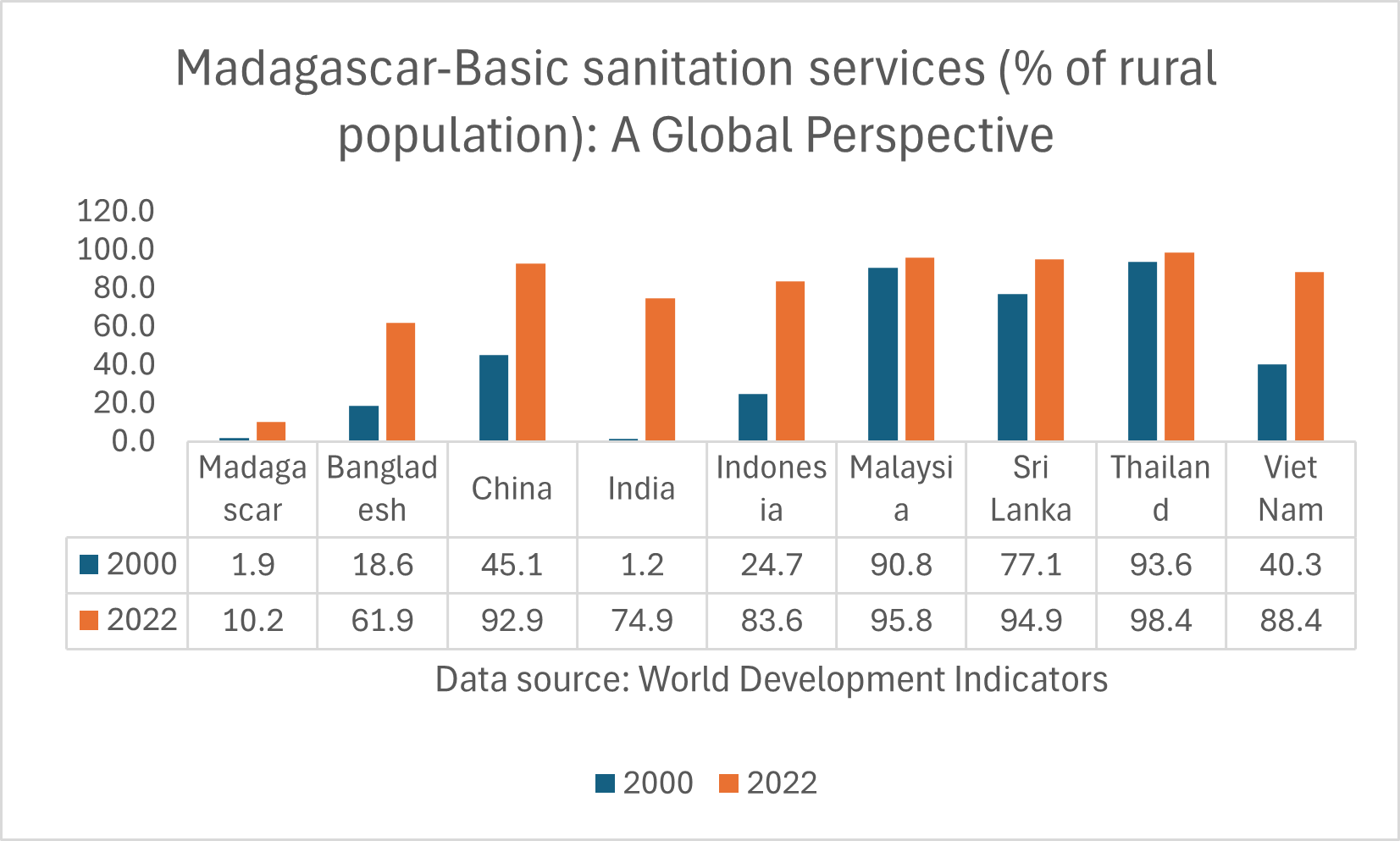
Madagascar-Water Supply
Madagascar – Proportion of total population served with at least basic water
In 2022, proportion of population served with at least basic water for Madagascar was 53.5 %. Proportion of population served with at least basic water of Madagascar increased from 36.9 % in 2000 to 53.5 % in 2022 an absolute change of 16.6 pp between 2000 and 2022.
Madagascar – Proportion of urban population served with at least basic water
In 2022, proportion of urban population served with at least basic water for Madagascar was 79.8 %. Proportion of urban population served with at least basic water of Madagascar increased from 71.4 % in 2000 to 79.8 % in 2022 an absolute change of 8.4 pp between 2000 and 2022.
Madagascar – Proportion of rural population with at least basic water
In 2022, proportion of rural population served with at least basic water for Madagascar was 36 %. Proportion of rural population served with at least basic water of Madagascar increased from 24.1 % in 2003 to 36 % in 2022 an absolute change of 11.9 pp between 2000 and 2022.
Madagascar- Proportion of population served with at least basic drinking water: A Global Perspective
Access to safe drinking water is a fundamental human right that demands immediate action from the global community to tackle a critical crisis. In 2022, nearly 14 million people in Madagascar, or about 46 percent of the population, were without this essential resource, highlighting a serious public health issue that requires our compassionate attention. In contrast, individuals in Thailand and 98 percent of people in Vietnam and Bangladesh had reliable access to safe drinking water that same year, revealing a shocking disparity that emphasizes the urgent need for a fundamental change in Sub-Saharan Africa. This situation underscores that many still lack the basic means to live healthy lives. We must unite to close this gap, ensuring everyone has access to safe drinking water, which is not just a convenience but a moral obligation that fosters a world where all individuals can thrive.

Madagascar- Proportion of rural population served with at least basic drinking water: A Global Perspective
In 2022, it is alarming that 64 percent of Madagascar’s rural population, around 12 million people, lacked access to safe drinking water, revealing a serious humanitarian crisis that demands urgent action from local and global communities. In contrast, countries like Thailand, Bangladesh, and Vietnam have achieved 100 percent, 98 percent, and 97 percent access to safe drinking water, demonstrating the effectiveness of targeted policies and infrastructure investment. This stark contrast not only highlights governance challenges faced by many Sub-Saharan African nations, including limited resources and political instability, but also underscores the urgent need for collaborative efforts to improve living conditions and ensure access to essential resources for vulnerable populations, fostering a more sustainable and equitable future for all.
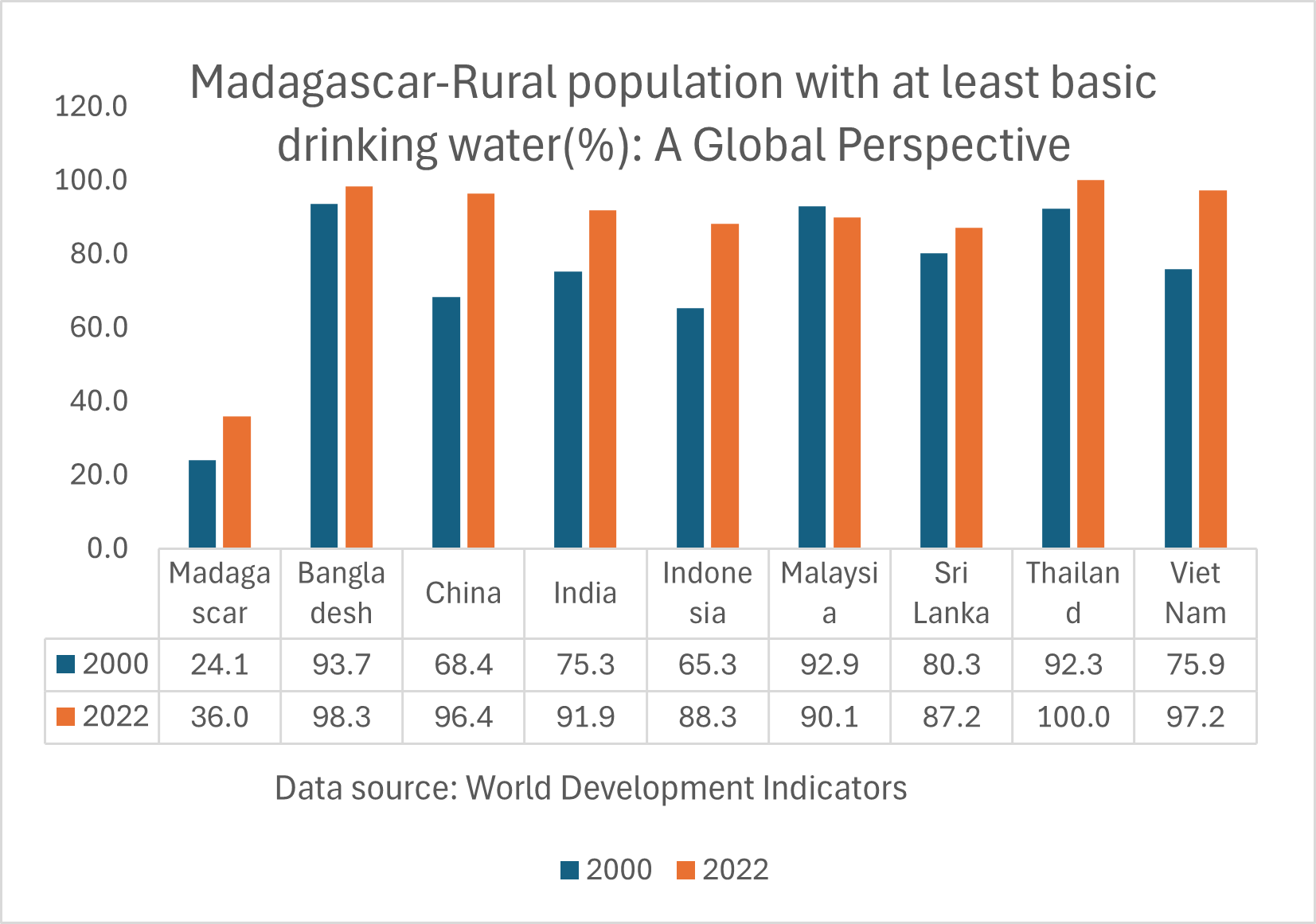
Madagascar-Access to Electricity
Madagascar-Access to electricity (% of population)
In 2022, proportion of population with access to electricity for Madagascar was 36.1 % in 2022. The proportion of population with access to electricity of Madagascar increased from 12.6% in 2000 to 36.1% in 2022, an absolute change of 23.5 pp between 2000 and 2022.
Madagascar-Access to electricity (% urban population)
In 2022, proportion of urban population with access to electricity for Madagascar was 71.6%. The proportion of urban population with access to electricity of Madagascar increased from 47.9% % in 2000 to 71.6% in 2022, an absolute change of 23.7 pp between 2000 and 2022.
Madagascar-Access to electricity (% of rural population)
In 2022, proportion of rural population with access to electricity for Madagascar was 10.9 %. The proportion of rural population with access to electricity of Madagascar increased from 6.7 % in 2020 to 10.9% in 2022, an absolute change of 4.2 pp between 2020 and 2022.
Madagascar- Proportion of population with access to electricity: A Global Perspective
In 2022, nearly 64 percent of Madagascar’s population lacked access to electricity, impacting over 19 million people and underscoring a dire crisis for survival and daily living. This situation is in sharp contrast to countries like Vietnam and Malaysia, which have achieved universal electricity access, highlighting the urgent need for systemic change in Sub-Saharan Africa. The absence of reliable electricity presents significant obstacles to development, health, education, and economic opportunities, all of which are essential for enhancing living standards and fostering sustainable futures for the people of Madagascar. It is crucial to address these challenges to empower communities and ensure that everyone has the opportunity to thrive.
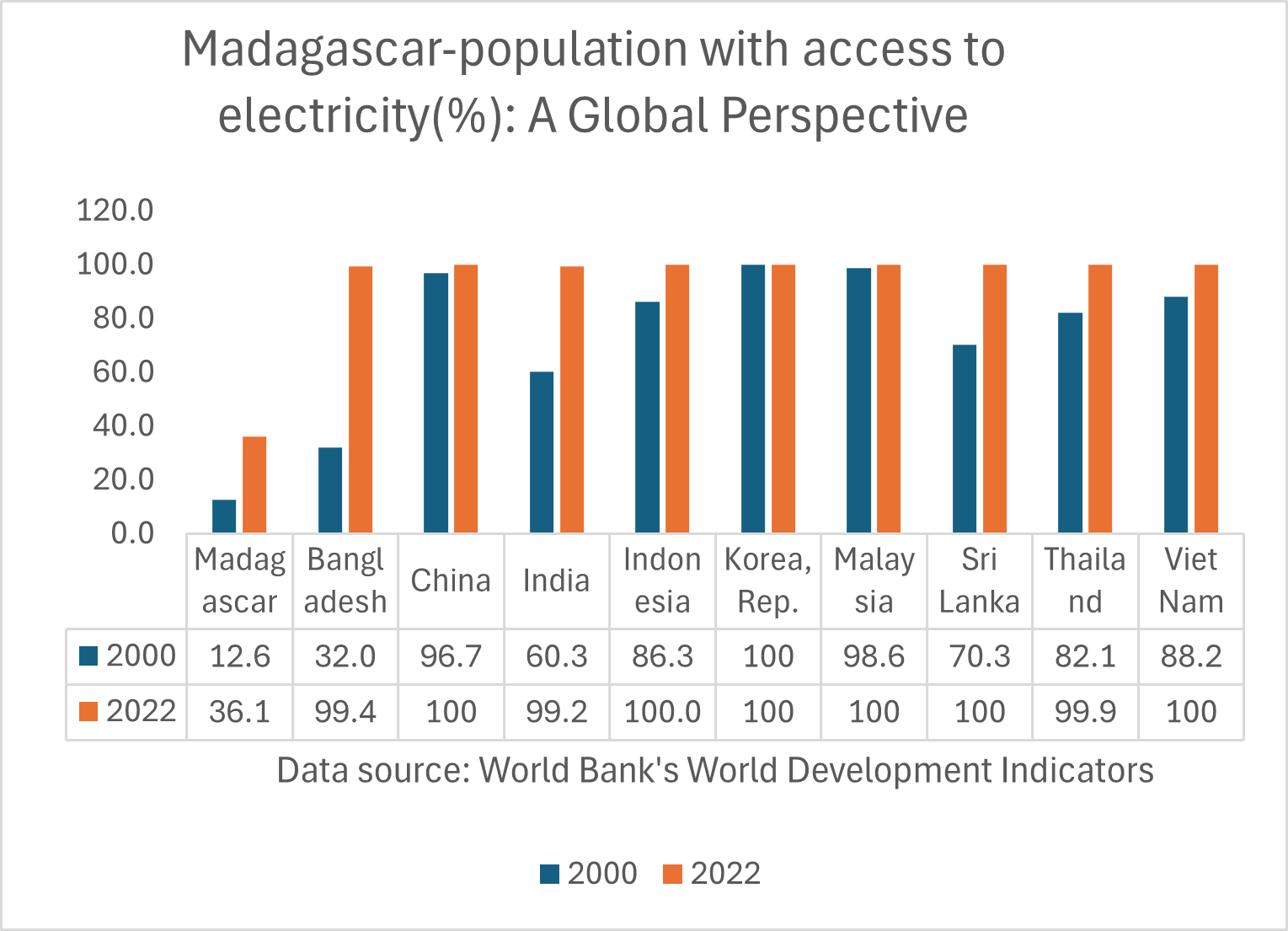
Madagascar- Proportion of rural population with access to electricity: A Global Perspective
In 2022, 89 percent of Madagascar’s rural population, nearly 15 million people, lived without electricity, revealing a stark gap compared to countries like Vietnam, Thailand, and Sri Lanka, where every rural resident has access to this essential need. Even India and Bangladesh provide reliable electricity to 99 percent of their rural populations, highlighting a troubling contrast that calls for urgent action. These statistics underscore the critical need for meaningful governance reforms across Sub-Saharan Africa to ensure every community has access to reliable electricity, thereby improving their quality of life and empowering them to achieve a sustainable and prosperous future with economic opportunities for all.
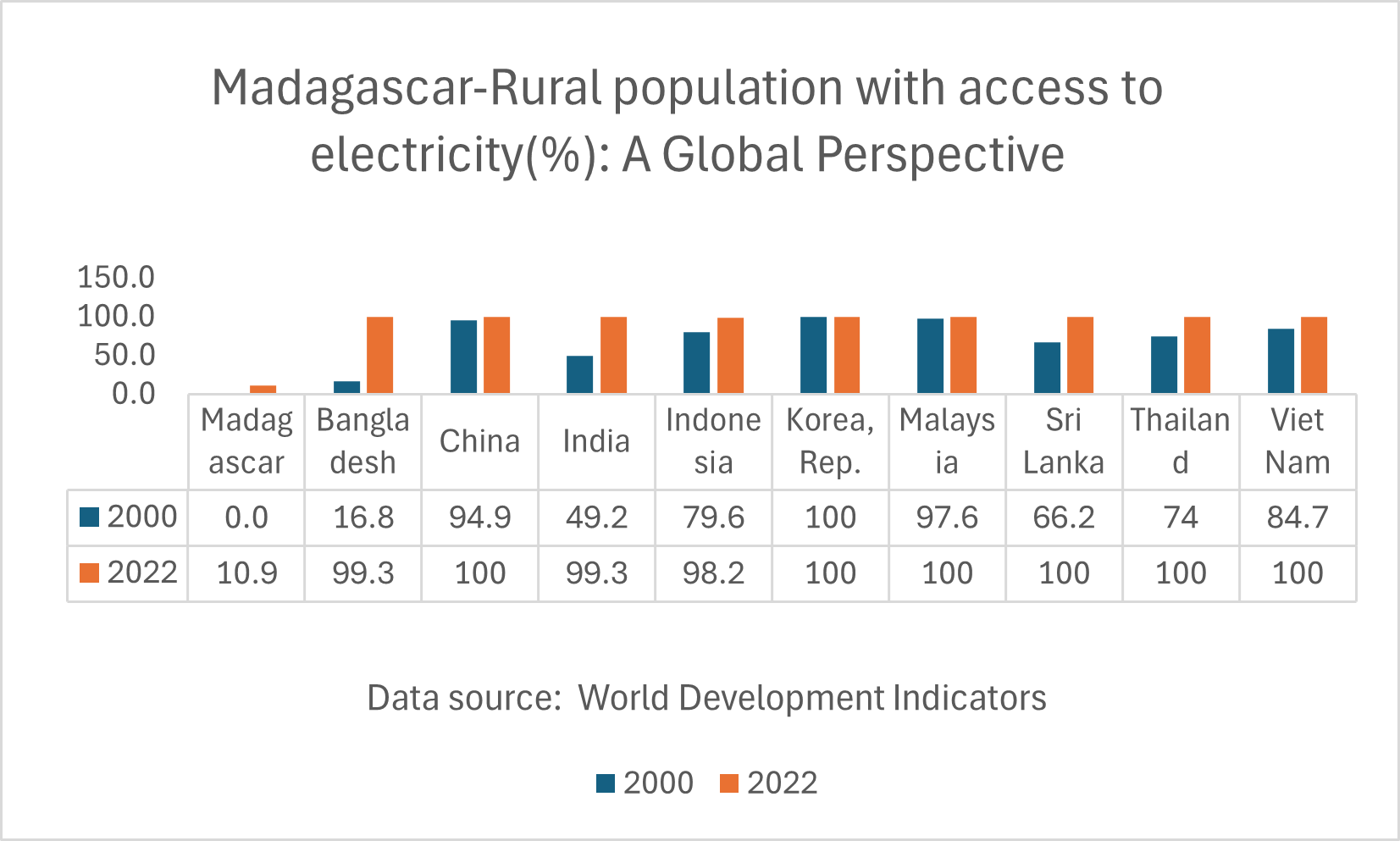
Madagascar: Health outcomes
Madagascar-Life expectancy: A Global Perspective
Madagascar’s life expectancy trends over the past seventy years reveal a complex narrative of progress and persistent challenges affecting its population. While the global average life expectancy for newborns rose from 47 years in 1950 to 71 years in 2022, Madagascar’s life expectancy increased from 43 years in 1960 to 65 years in 2022, reflecting ongoing challenges faced by its people. In contrast, countries like South Korea have significantly improved, with life expectancy soaring from 54 years in 1960 to 83 years in 2022, while the Maldives advanced from 39 years in 1960 to 81 years in 2022. The lower life expectancy in many Sub-Saharan African nations highlights the intricate challenges they confront, including chronic poverty, inadequate healthcare, and governance issues, emphasizing the urgent need for transformative efforts to create a sustainable and equitable future for these communities.
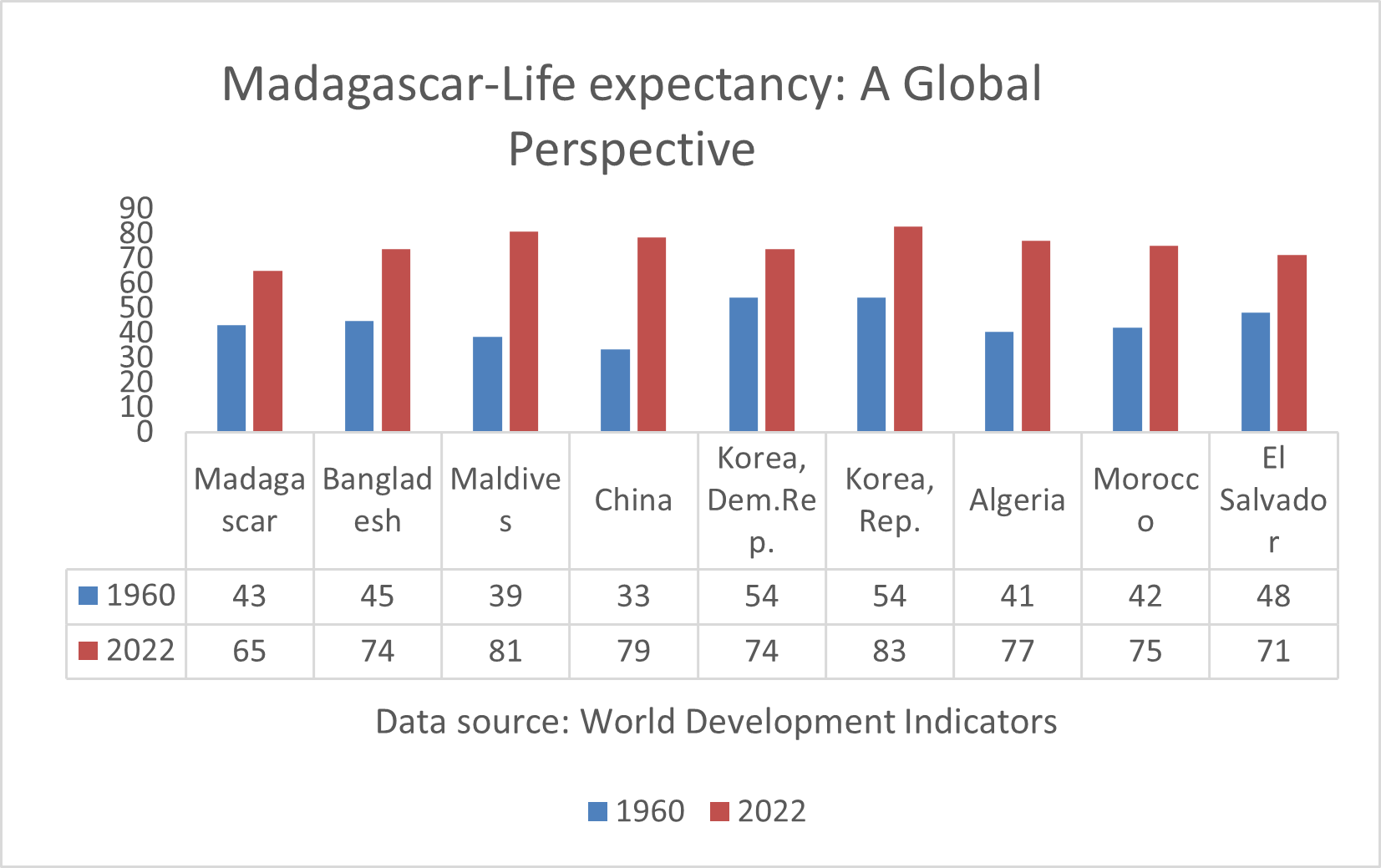
Madagascar-Mortality rate, under-5 (per 1,000 live births): A Global Perspective
Since 1950, child mortality rates globally have seen a significant decline, mainly due to improvements in living standards, healthcare access, nutrition, and safe drinking water. In wealthier regions like Europe and America, child mortality has fallen to below four percent, showcasing the benefits of strong healthcare systems and socioeconomic stability. While many developing countries across South America, Asia, and Africa have made progress, Sub-Saharan Africa faces slow and uneven advancements. Madagascar’s under-five mortality rate decreased from 171 in 1980 to 66 in 2022. Conversely, Bangladesh and India have achieved remarkable reductions, with rates plummeting from 206 to 29 and 169 to 29, respectively. These figures reflect ongoing challenges posed by inadequate healthcare systems and emphasize the urgent need for structural reforms and international collaboration to improve health outcomes for vulnerable populations.

Madagascar-Maternal mortality ratio (per 100,000 live births): A Global Perspective
Madagascar’s maternal mortality ratio, although decreasing from 658 in 2000 to 392 in 2020, remains a critical issue that highlights the ongoing risks mothers face across the country. This decline is overshadowed by the significantly lower rates in countries like Bangladesh, India, and Vietnam, which reported figures of 123, 103, and 46 in 2022. These troubling statistics reveal the persistent crisis of pregnancy-related fatalities in Madagascar, worsened by high birth rates and systemic flaws in maternal healthcare that require urgent action. The stark disparities in maternal health outcomes compared to other regions emphasize the need for substantial investments in healthcare infrastructure and resources to ensure the safety and well-being of mothers and children. Addressing these challenges is essential for transforming the current struggles into a future where health and hope thrive for families in Madagascar.
